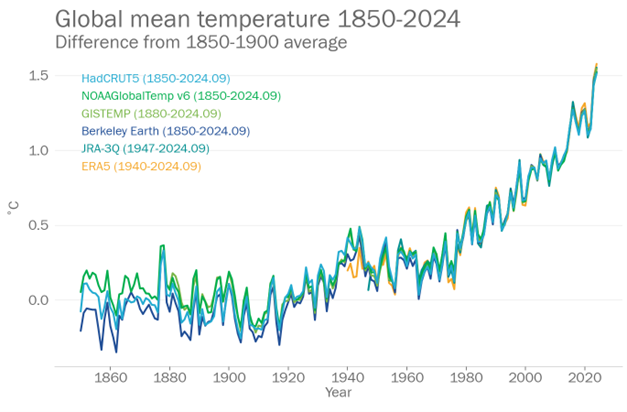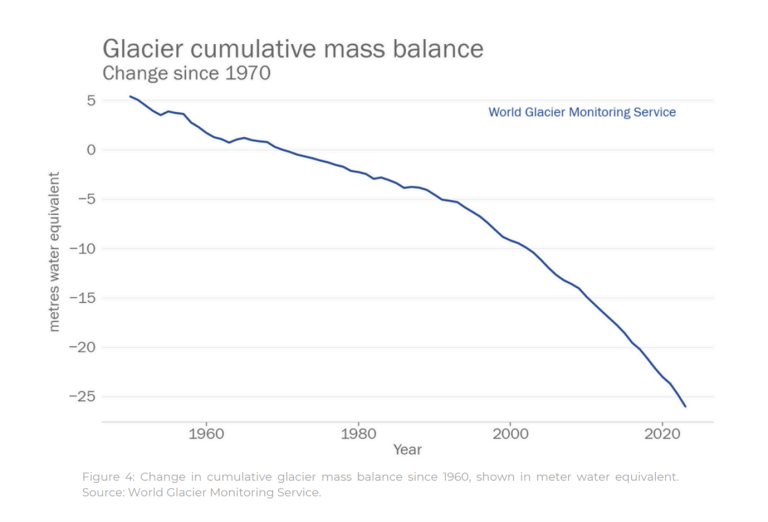2024 is on track to be hottest year on record as warming temporarily hits 1.5°C

The year 2024 is on track to be the warmest year on record after an extended streak of exceptionally high monthly global mean temperatures, according to the World Meteorological Organization (WMO).
Key messages
- Jan-Sept 2024 global average temperature 1.54 (±0.13) °C above pre-industrial level
- Long-term warming measured over decades remains below 1.5°C
- Past 10 years are warmest on record and ocean heat rises
- Antarctic sea ice second lowest on record and glacier loss accelerates
- Extreme weather and climate events lead to massive economic and human losses
The WMO State of the Climate 2024 Update once again issues a Red Alert at the sheer pace of climate change in a single generation, turbo-charged by ever-increasing greenhouse gas levels in the atmosphere. 2015-2024 will be the warmest ten years on record; the loss of ice from glaciers, sea-level rise and ocean heating are accelerating; and extreme weather is wreaking havoc on communities and economies across the world.
The January - September 2024 global mean surface air temperature was 1.54 °C (with a margin of uncertainty of ±0.13°C) above the pre-industrial average, boosted by a warming El Niño event, according to an analysis of six international datasets used by WMO.
"Climate catastrophe is hammering health, widening inequalities, harming sustainable development, and rocking the foundations of peace. The vulnerable are hardest hit," said UN Secretary-General António Guterres.
The report was issued on the first day of the UN Climate Change Conference, COP29, in Baku, Azerbaijan. It highlights that the ambitions of the Paris Agreement are in great peril.
"As monthly and annual warming temporarily surpass 1.5°C, it is important to emphasize that this does NOT mean that we have failed to meet Paris Agreement goal to keep the long- term global average surface temperature increase to well below 2°C above pre-industrial levels and pursue efforts to limit the warming to 1.5°C," said WMO Secretary-General Celeste Saulo.
"Recorded global temperature anomalies at daily, monthly and annual timescales are prone to large variations, partly because of natural phenomenon such as El Niño and La Niña. They should not be equated to the long-term temperature goal set in the Paris Agreement, which refers to global temperature levels sustained as an average over decades," she said.
"However, it is essential to recognize that every fraction of a degree of warming matters. Whether it is at a level below or above 1.5°C of warming, every additional increment of global warming increases climate extremes, impacts and risks," said Celeste Saulo.
"The record-breaking rainfall and flooding, rapidly intensifying tropical cyclones, deadly heat, relentless drought and raging wildfires that we have seen in different parts of the world this year are unfortunately our new reality and a foretaste of our future," said Celeste Saulo. "We urgently need to reduce greenhouse gas emissions and strengthen our monitoring and understanding of our changing climate. We need to step up support for climate change adaptation through climate information services and Early Warnings for All," she said.

Annual global mean temperature anomalies from January - September 2024 (relative to the 1850-1900 average) from six international datasets.
Highlights
Temperature
The global mean temperature in 2024 is on track to outstrip the temperature even of 2023, the current warmest year. For 16 consecutive months (June 2023 to September 2024), the global mean temperature likely exceeded anything recorded before, and often by a wide margin, according to WMO's consolidated analysis of the datasets.
One or more individual years exceeding 1.5°C does not necessarily mean that "pursuing efforts to limit the temperature increase to 1.5°C above pre-industrial levels" as stated in the Paris Agreement is out of reach. The exceedance of warming levels referred to in the Paris Agreement should be understood as an exceedance over an extended period, typically decades or longer, although the Agreement itself does not provide a specific definition.
As global warming continues, there is an urgent and unavoidable need for careful tracking, monitoring and communication with regard to where the warming is relative to the long-term temperature goal of the Paris Agreement, to help policymakers in their deliberations. To support this, WMO has established an international team of experts, and the initial indication is that long-term global warming is currently likely to be about 1.3°C compared to the 1850-1900 baseline.
Greenhouse Gases
Greenhouse Gases reached record observed levels in 2023. Real time data indicate that they continued to rise in 2024. The atmospheric concentration of carbon dioxide (CO2) has increased from around 278 ppm in 1750 to 420 ppm in 2023, an increase of 51%. This traps heat and causes temperatures to rise.
Ocean
Ocean heat content in 2023 was the highest on record and preliminary data show 2024 has continued at comparable levels. Ocean warming rates show a particularly strong increase in the past two decades. From 2005 to 2023, the ocean absorbed on average approximately 3.1 million terawatt-hours (TWh) of heat each year. This is more than 18 times the world's energy consumption in 2023.
About 90% of the energy that has accumulated in the Earth system is stored in the ocean and it is therefore expected that ocean warming will continue - a change that is irreversible on centennial to millennial timescales.
Sea level rise
Sea level rise is accelerating because of thermal expansion of warmer waters and melting glaciers and ice sheets. From 2014-2023, global mean sea level rose at a rate of 4.77 mm per year, more than double the rate between 1993 and 2002. The El Niño effect meant it grew even more rapidly in 2023. Preliminary 2024 data shows that, with the decline of El Niño, it has fallen back to levels consistent with the rising trend from 2014 to 2022.
Glacier loss
Glacier loss is worsening. In 2023, glaciers lost a record 1.2-meter water equivalent of ice - about five times the amount of water in the Dead Sea. It was the largest loss since measurements began in 1953 and was due to extreme melting in North America and Europe. In Switzerland, glaciers lost about 10% of their remaining volume in 2021/2022 and 2022/2023.

World Glacier Monitoring Service
Sea ice extent
Antarctic sea-ice extent - both the annual minimum in February and the maximum in September - was the second lowest in the satellite record (1979-2024) after 2023. Arctic sea-ice minimum extent after the summer melt was the seventh lowest in the satellite record and the maximum was just below the long-term average of 1991-2020.
Weather and climate extremes
Weather and climate extremes undermined sustainable development across the board, worsening food insecurity and exacerbating displacement and migration. Dangerous heat afflicted many millions of people throughout the world. Heavy precipitation, floods and tropical cyclones led to massive loss of life and damage. Persistent drought in some regions was worsened by El Niño.
The section on climate impacts, provided by United Nations partners, will be expanded in the final report on the State of the Global Climate 2024, due to be published in March 2025.

GPCC
Climate services and early warnings
Climate services and early warnings have made progress in the past five years. There have been advances in Early Warnings for All (EW4All) to ensure that everyone is protected from hazardous weather, water, or climate events through life-saving early warning systems by the end of 2027. 108 countries report having a Multi-Hazard Early Warning System.
Understanding climate variability and change is crucial for optimizing renewable energy generation, ensuring energy system resilience, and analyzing energy demand patterns, especially for heating and cooling.